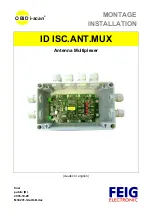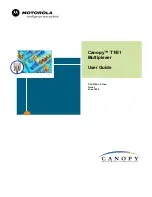
Theory of Operation
—DM 5010
Counter U1235,
set to binary zero by the CLR pulse at
the end of
the measurement period, selects the
least signifi
cant bit of data (at the Eo input of U1125) to be output to the
data bus
via U1030A, U1030B,
and the Miscellaneous buff
er (diagram
9). As the processor beings its reading se
quence,
it reads this bit of
data, and then generates an
ADVANCE
pulse
via the Address Decode
circuitry (diagram
7)
to increment the counter U1235.
The next LSB of data
(Ej) is
now selected by U1125 and is applied to the data
bus. The processor continues reading data and
advancing
counter
U1235 in this
fashion until all
16 bits
of data
selectable
by
U1125 have been read. The next ADVANCE
pulse generated
by the processor causes a ripple-carry at
pin
15 of U1235, and U1320 changes state. U1030A is dis
abled
and
the
17th bit of conversion data
stored in the dis
crete
flip-flop (U1135C
and K1030C)
is passed on to the
data
bus
via
U1030D, U1030B and the
Miscellaneous
buffer.
MICROPROCESSOR <$>
The Microprocessor is
the control center for all instru
ment operations. Operating
under firmware control, the var
ious types of data in
the System are moved about and
manipulated by
the
microprocessor.
By addressing (select
ing)
the various
devices or
memory locations in the proper
sequence
(firmware control) and by properly manipulating
and transferring the data associated with these addresses,
each portion of the
instrument performs its correct function
at the
correct time.
The DM5010, as do all microprocessor systems, re
quires
a system
clock. The 4 MHz crystal, Y1221, provides
a
stable and
accurate timing element for the
microprocessor
’s
internal clock oscillator. All other critical
timing
signals
in the instrument are derived from the inter
nally-divided 02 (1 MHz)
clock.
The
VMA (Valid Memory Access) and R/W (read/write)
lines
control
the enabling
of
devices o
n the data bus as well
as
the flow of data on the bus. The IRQ line (interrupt re
quest) is used in
conjunction with GPIB data transfers,
which are explained in the Handshake Process. The remain
ing
processor control
lines,
with
the exception
of the
RESET,
are
not used. The function of the RESET line is
explained
in the following description.
POWER-ON
LOGIC
<?>
The Power-On Logic holds
the DM 5010 circuitry in a
reset condition
for
a
short time after power up,
or when a
momentary power supply fault occurs. This
ensures
that the
+ 5V
supply has settled and that all instrument functions
begin
from
a known state.
As
instrument power is turned on, the + 5V supply
comes
up from 0 V to
+5 V over some finite time
period.
During
most of this time, the inverting input of U1230B is
more positive
than the noninverting input,
keeping the out
put, at
pin 7 low, and thus the system reset (PON at pin 1
of
U1230A)
at ground
potential. As the supply
voltage reaches
approximately
+4.7 V, the noninverting input at pin 5 goes
more
positive
than the input at pin 6. As this occurs, the
output
transistor of comparator U1230B
(an open collector
device) is turned
off.
Capacitor
C1223
now charges 5 V through
R1227,
As the voltage across C1223 charges beyond
+
2.75 V, the inputs to
comparator U1230A change relative
polarity
and the system reset (PON) level at output pin 1
goes
high. As previously mentioned, the time delay incorpo
rated in this
circuitry
ensures that the
+5 V supply has had
time
to settle before
any operation is attempted.
ADDRESS
BUS BUFFER <7>
The
Address
Buffer stage consists of U1235 and
U1420A.
This stage
provides
the increased current drive re
quired
to
address the many devices on the Address Bus.
ADDRESS DECODE <j>
The Address
Decode circuitry may be thought of as an
extension
of the
address bus. This stage looks at the six
most-significant bits of the address bus along with two
function-dependent signals
produced by the microprocesor
to
generate many of the required enable
and control signals
for
specific
devices within the instrument.
A
high
VMA (Valid Memory Access) signal, as does its
inverted
counterpart
(low BVMA), indicates that the infor
mation
on the address bus is pointing to a valid memory
location. When these signals
are
present,
decoders U1510,
U1520,
and U1620
along with U1720A, U1720B, U1730A,
and
U1730B in the
logic state, generate the enable
and con
trol signals
as shown in Table 4-4.
The memory map shown
in Table 4-5 further illustrates address decoding. Those sig
nals associated with U1620 are all
synchronized to the
microprocessor by the
<t>2
clock.
ADD
JAN
1982
4-21
Summary of Contents for DM 5010
Page 14: ...DM 5010 2994 00 DM 5010 Programmable Digital Multimeter xii ADD JUL 1986...
Page 27: ...Operating Instructions DM 5010 2994 03 Fig 2 3 DM 5010 front panel controls and connectors 2 3...
Page 38: ......
Page 134: ......
Page 208: ......
Page 222: ......
Page 250: ......
Page 251: ...Section 8 DM 5010 OPTIONS No options are available 8 1...
Page 252: ......
Page 270: ......
Page 272: ...DM 5010 2994 37 Fig 10 2 Location of DM 5010 adjustments and test points...
Page 273: ......
Page 274: ......
Page 275: ......
Page 276: ...DM 5010 2994 112 DM 5010 BLOCK DIAGRAM...
Page 281: ......
Page 282: ......
Page 291: ......
Page 293: ......
Page 294: ......
Page 297: ......
Page 298: ......
Page 303: ......
Page 304: ...I...
Page 305: ......
Page 310: ......
Page 311: ......
Page 315: ......
Page 318: ......
Page 321: ......
Page 323: ......
Page 326: ......
Page 332: ...2994 57...
Page 334: ......
Page 335: ......
Page 336: ......
Page 337: ...63 REV JUN 1986...
Page 338: ...FIG 1 EXPLODED DM 5010...
Page 339: ......
Page 340: ......
Page 341: ......
Page 347: ......
















































